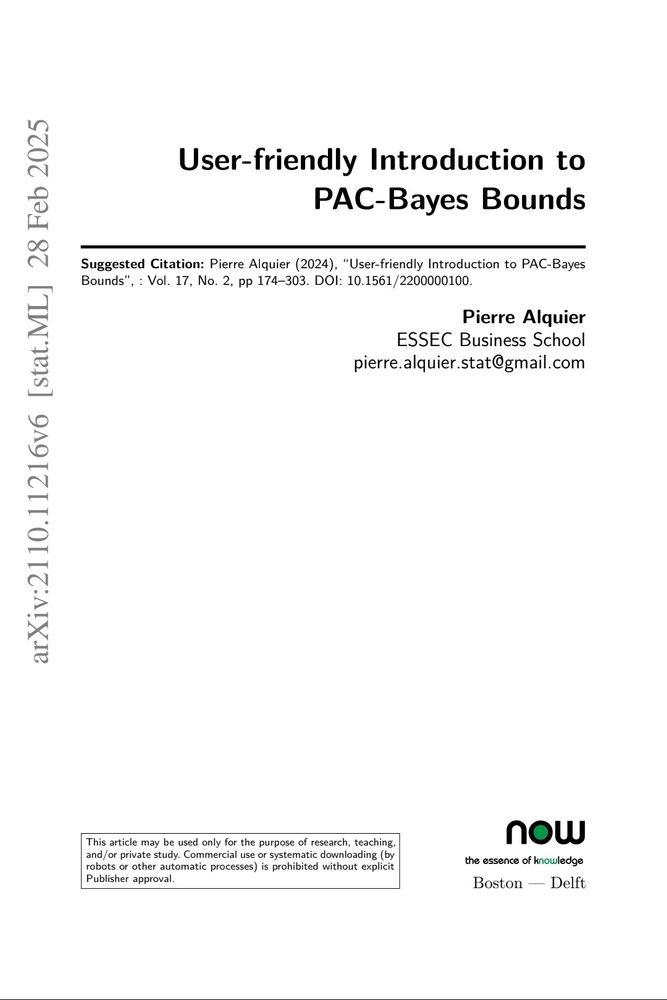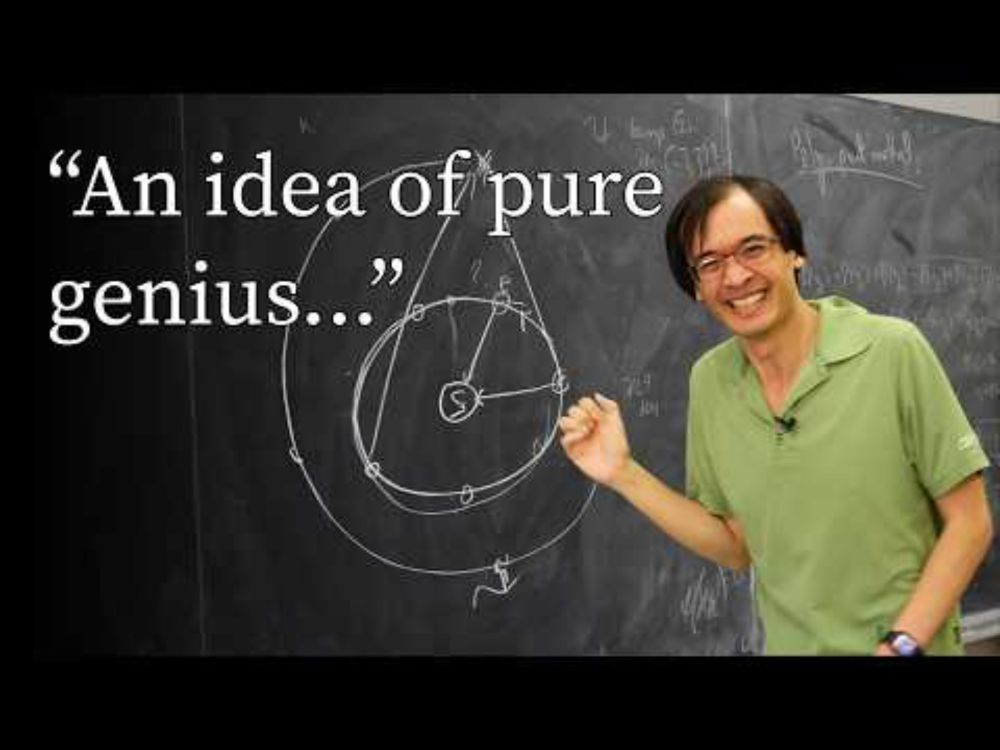In the world of sphere packing, there’s been debate about whether order or a dash of chaos will give the best results. A recent proof marks a win for order. www.quantamagazine.org/new-sphere-p...
07.07.2025 14:27 — 👍 23 🔁 6 💬 0 📌 0

And a recent very well written review of NS:
"Nested sampling for physical scientists"
arxiv.org/abs/2205.15570
23.06.2025 11:32 — 👍 2 🔁 0 💬 0 📌 0
Nested Sampling is extremely popular in some communities, and there are often claims that it helps mitigate "phase transition" issues that can often affect standard geometric "tempering" methods (although I do not understand that well enough yet...) It's great to see explicit connections with SMC!
23.06.2025 11:29 — 👍 0 🔁 0 💬 1 📌 0
A simpler nested sampling identity – Statisfaction - I can’t get no
"A simpler nested sampling identity"
Interesting blogpost on nested sampling & SMC by Nicolas Chopin
statisfaction-blog.github.io/posts/04-06-...
23.06.2025 11:17 — 👍 7 🔁 0 💬 1 📌 0
See you in 🇸🇬
15.06.2025 11:46 — 👍 2 🔁 0 💬 0 📌 0
My bad, this wasn't clear. It's in the space of all probability densities
13.06.2025 18:29 — 👍 0 🔁 0 💬 0 📌 0
And here is how the geodesic path looks like (again under the Fisher-Rao metric)
13.06.2025 16:30 — 👍 6 🔁 0 💬 1 📌 0
Here's how the gradient flow for minimizing KL(pi, target) looks under the Fisher-Rao metric. I thought some probability mass would be disappearing on the left and appearing on the right (i.e. teleportation), like a geodesic under the same metric, but I was very wrong... What's the right intuition?
13.06.2025 16:29 — 👍 23 🔁 6 💬 4 📌 0
Once you have tried symplectic integrators, you never go back.
07.06.2025 21:34 — 👍 46 🔁 3 💬 6 📌 0
The full (?) program of talks etc. for BayesComp seems to be online now (bayescomp2025.sg#programme), and looks pretty exciting - I will need to set aside some time to carve out my own schedule!
01.06.2025 12:03 — 👍 26 🔁 3 💬 0 📌 0
Once the prompt is public, I do not think it will provide much signal (but it could potentially slightly help some the papers make sure their writing style align well with the conference expectations)
17.05.2025 09:17 — 👍 1 🔁 0 💬 1 📌 0
How to implement this in practice, make the "review" prompt public in advance?
17.05.2025 08:57 — 👍 1 🔁 0 💬 1 📌 0
<proud advisor>
Hot off the arXiv! 🦬 "Appa: Bending Weather Dynamics with Latent Diffusion Models for Global Data Assimilation" 🌍 Appa is our novel 1.5B-parameter probabilistic weather model that unifies reanalysis, filtering, and forecasting in a single framework. A thread 🧵
29.04.2025 04:48 — 👍 50 🔁 15 💬 2 📌 3
These sparse Gaussian Processes have been around longer than some grad students, but still fun to code! (and today was my first time coding one...)
19.04.2025 15:18 — 👍 8 🔁 1 💬 0 📌 0

Today, re-reading a classic.. the 1953 paper that started it all
11.04.2025 09:00 — 👍 9 🔁 0 💬 0 📌 0
Is it based on the last year's preprint by Huhtikuun Typerys?
01.04.2025 13:19 — 👍 2 🔁 0 💬 1 📌 0
Cute way to upper bound the connective constant of Z^d. For some length L, enumerate {w_1, w_2, ... , w_N} the Self-Avoiding-Walks of size L. An upper bound is given by the largest eigenvalue of the NxN matrix where M_{i,j}=1 iff there is a SAW of size (L+1) that starts with w_i and ends with w_j.
01.04.2025 09:42 — 👍 1 🔁 0 💬 1 📌 0
Ah, but this paper seems to be confident that the conjecture is wrong, based on extensive simulations for estimating the connective constant up to 12 decimals (at which point there is a departure from the conjectured value). Still open though 😅
arxiv.org/pdf/1607.02984
01.04.2025 03:49 — 👍 1 🔁 0 💬 0 📌 0

Approximating N(L), the number of Self-Avoiding-Walks in Z^2 of length L, is an assignment in my Simulation course this year. The connective constant is:
C = \lim N(L)^1/L ~ 2.638..
Still open-problem to this day: is it true that 1/C equals the zero of the polynomial P(x)=581*x^4 + 7*x^2 - 13 😱
01.04.2025 03:19 — 👍 5 🔁 0 💬 1 📌 1
That's interesting that it seems like very little is known about the asymptotic of the second largest increasing subsequence (and no fast method to compute it)
30.03.2025 07:23 — 👍 3 🔁 0 💬 0 📌 0

This fast way of finding the LIS is neat! Just tried to reproduce your nice plot without leaving the phone 😊
chatgpt.com/share/67e8ec...
30.03.2025 07:06 — 👍 1 🔁 0 💬 1 📌 0
Sequential Monte Carlo (aka. Particle Socialism?):
"why send one explorer when you can send a whole army of clueless one"
29.03.2025 08:32 — 👍 12 🔁 2 💬 0 📌 0

Next week is the MCMC chapter of my simulation course. Asked chatgpt to come up with a funny drawing:
29.03.2025 08:08 — 👍 38 🔁 5 💬 3 📌 2

I already advertised for this document when I posted it on arXiv, and later when it was published.
This week, with the agreement of the publisher, I uploaded the published version on arXiv.
Less typos, more references and additional sections including PAC-Bayes Bernstein.
arxiv.org/abs/2110.11216
05.03.2025 01:16 — 👍 109 🔁 22 💬 1 📌 3
Home | AAAI'25 tutorial
The AAAI'25 tutorial on Tensor Factorizations + Probabilistic Circuits
Are you at AAAI in Philadelphia and interested about #tensor-factorizations or #circuits or even both?
Then join us today at our tutorial: "From tensor factorizations to circuits (and back!)"
Details and materials here
april-tools.github.io/aaai25-tf-pc...
Time 4:15pm - 6:00pm, Room 117
25.02.2025 17:38 — 👍 31 🔁 11 💬 0 📌 2
YouTube video by 3Blue1Brown
Terence Tao on how we measure the cosmos | Part 1
New video! Terence Tao on how we measure the cosmos: youtu.be/YdOXS_9_P4U
08.02.2025 13:46 — 👍 445 🔁 81 💬 23 📌 24
Sr Researcher at Microsoft Research AI for Science
Former Oxford Stats PhD in Bayesian Experimental Design
Social science and other distractions. Old posts get deleted pretty quick.
https://kieranhealy.org /
https://theordinalsociety.com
Data, analysis, visualization, #CensusMapper, transportation cyclist.
📍Vancouver, BC
dad from hampshire, mostly found on linkedin talking stats
Incoming Assistant Professor in Statistical Machine Learning @ NTU Singapore 🇸🇬 Interested in Uncertainty-aware ML, Explainable ML, and preference learning.
Currently Postdoc @CISPA, previously at @OXCSML, @Amazon, @MPI_IS
https://chau999.github.io/
Incoming postdoc @ProbAIHub, hosted @warwickstats @Princeton @orfe. PhD @GatsbyUCL. Works on universality and ML theory. He/him. 🌈
kevinhanhuang.page
Prof. at Univ. Rennes 2
ML for time series + a bit of Optimal Transport
Maintainer of tslearn
rtavenar.github.io
Physics PhD candidate
UC Santa Barbara | Geometric Intelligence Lab
AI, geometry, dynamics, complex systems
prev physics at MIT
AI researcher @ atmo.ai
Researching planning, reasoning, and RL in LLMs @ Reflection AI. Previously: Google DeepMind, UC Berkeley, MIT. I post about: AI 🤖, flowers 🌷, parenting 👶, public transit 🚆. She/her.
http://www.jesshamrick.com
The new foundation for documents: Limitless power to write, create, and automate anything that you can fit on a page.
Research scientist & computational chemist at Berkeley Lab using HT DFT workflows, machine learning, and reaction networks to model complex reactivity.
Incoming: Editing politics at Zeteo. Contributing writer at Rolling Stone. aperez.03 on signal.
Research Engineer at Google DeepMind
A special snowflake existing in 196883 dimensions
#ActuallyAutistic He/Him
AI, robotics, and other stuff. Currently AI @ agility robotics
Former Hello Robot, NVIDIA, Meta.
Writing about robots https://itcanthink.substack.com/
All opinions my own
Assistant Professor at Dartmouth College
Computational Biophysics / Disordered Proteins / Molecular Recognition
Associate Professor at Chalmers. AI for molecular simulation and inverse design. WASP Fellow. ELLIS Member. https://userpage.fu-berlin.de/solsson/
datamancer, generative models, bayesian inference, dynamical systems, open-source software, phd with @glouppe.bsky.social
AI for humans and for science.
https://danmackinlay.name
Research scientist @ CSIRO 🇦🇺
I'm that blogger from your search result sources list. Research areas: ml for physics, causal inference, AI safety and economic
Data Scientist (Forecasting) @NVIDIA. Interested in Bayesian stats, causal inference, and decisions. Also dad, OEF vet, and ski/mountain enjoyer.
I blog (throw bricks into the wind) @ www.nelsontang.com















